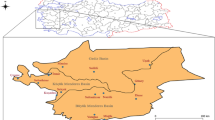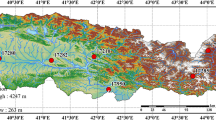Abstract
The most parts of the Earth experience precipitation variability as a part of their normal climates over both short- and long-time periods. These variations of precipitation will have unpredictable and perhaps unexpectedly extreme consequences (such as drought and flood) with respect to frequency and intensity for many regions of the Earth. Because of high precipitation fluctuations, the Mediterranean region is also the areas of the world sensitive to precipitation changes which often involve frequent drought conditions in Turkey. In this study, drought conditions at annual, seasonal and monthly time scales over the period of 1975–2010 were examined for Antakya-Kahramanmaraş Graben which is located in the eastern part of the Mediterranean region of Turkey. Application of appropriate measures to analyze and monitor droughts is recognized as a major challenge to scientists involved in atmospheric studies. Standardized Precipitation Index (SPI) and cumulative deviation curve techniques were used to determine drought conditions. Results indicated that the study area presented a cyclic pattern of variations with alternating drier and wetter years. From analyses of annual, seasonal and monthly drought series it can be seen that precipitation characteristic of the area is changing. By the results, apparent wet and dry periods can be distinguished. This study also indicated that precipitation totals of winter, spring and summer seasons were slightly decreased during the study period. Drought frequency was increased especially for the northern part of the area in the last ten years. Drought periods were divided into 1982–1985, 1999–2002 and 2004–2008, respectively. According to our analyses, the time scale of 1999–2002 was the driest period in the most of the graben area. The study area, which covers agriculturally important fertile alluvial plains, will experience increasing pressure on its water resources because of its growing population and industry, ever-larger demands for intensive agricultural activities, and frequent drought events.
Similar content being viewed by others
References
Beniston M. 2007. Current and future trends of climatic extremes in Switzerland. Geography Compass, 1(4): 739–751.
Bonaccorso B, Bordi I, Cancelliere A, et al. 2003. Spatial variability of drought: an analysis of the SPI in Sicily. Water Resources Management, 17: 273–296.
Bordi I, Frigio S, Parenti P, et al. 2001. The analysis of the standardized precipitation index in the Medditerranean area: large-scale patterns. Annals of Geophysics, 44: 965–978.
Bordi I, Fraedrich K, Petitta M, et al. 2005. Large-scale analysis of drought in Europe using Ncep/Ncar and Era-40 re-analaysis data sets. European Water, 9(10): 35–42.
Buishand T A. 1982. Some methods for testing the homogeneity of rainfall records. Journal of Hydrology, 58: 11–27.
Burn D H, Elnur M A H. 2002. Detection of hydrologic trends and variability. Journal of Hydrology, 225: 107–122.
Chakraborty S, Chaube U C, Mishra S K, et al. 2013. Trend and variability analysis of rainfall series at Seonath River Basin. Chhattisgarh (India). Journal of Applied Sciences and Engineering Research, 2 (4): 425–434.
Deniz A, Karaca M. 1995. Analysis of cyclone tracks over Turkey. Journal of ITU, 53: 59–66. (in Turkish)
Dracup J A, Lee K S, Paulson E G. 1980. On the definition of droughts. Water Resources Research, 16(2): 297–302.
Eshel G, Farrell B F. 2000. Mechanisms of Eastern Mediterranean rainfall variability. Journal of Atmospheric Sciences, 57: 3219–3232.
Giddins L, Soto M, Rutherford B M, et al. 2005. Standardized precipitation index zones for Mexico. Atmósfera, 18(1): 33–56.
Huseyinova R, Kulbay H G, Bilgin A, et al. 2009. Precipitation trends in Kahramanmaraş along with Gaziantep and Adiyaman during the period of 1963–2005. Ekoloji, 18(71): 15–27.
IPCC. 2007. Climate Change 2007: The Physical Science Basis. Cambridge: Cambridge University Press.
Kadioglu M. 2000. Regional variability of seasonal precipitation over Turkey. International Journal of Climate, 20: 1743–1760.
Khalil A, El-Kadi A. 2001. Variation of rainfall and drought conditions in Gaza-Palestine: on a regional and global context. Journal of the Islamic University of Gaza, 2: 41–66.
Khan S, Gabriel H F, Rana T. 2008. Standard precipitation index to track drought and assess impact of rainfall on water tables in irrigation areas. Irrigation and Drainage Systems, 22: 159–177.
Koçman A, Isik S, Mutluer M. 1995. Rainfall variability and drought problems in the Aegean plains. Aegean Geographical Journal, 8: 25–36.
Kömüsçü A Ü, Erkan A. 2011. Drought and an overall assessment for Turkey. State Meteorology Works. [2014-05-20]. http//:www.mgm.gov.tr.
Lazaro R, Rodrigo F S, Gutierrez L, et al. 2001. Analysis of a 30-year rainfall record (1967–1997) in semi-arid SE Spain for implications on vegetation. Journal of Arid Environments, 48: 373–395.
Liu D, Guo S, Chen X, et al. 2012. Analysis of trends of annual and seasonal precipitation from 1956 to 2000 in Guangdong Province, China. Hydrological Sciences Journal, 57(2): 358–369.
McKee T B, Doesken N J, Kleist J. 1993. The relationship of drought frequency and duration to time scales. Eighth Conference on Applied Climatology, 17–22 January, Anaheim, California: American Meteorological Society, 179–184.
Moreira E E, Paulo A A. Pereira L S, et al. 2006. Analysis of SPI drought class transitions using loglinear models. Journal of Hydrology, 331: 349–359.
Nalbantis I, Tsakiris G. 2009. Assessment of hydrological drought revisited. Water Resources Management, 23: 881–897.
Osanaiye P A, Talabi C O. 1989. On some non-manufacturing applications of counted data cumulative sum control chart schemes. The Statistician, 38: 251–257.
Pamuk G, Özgürel M, Topçuoglu K. 2004. Drought analysis in the Aegean region with standardized precipitation index (SPI). Journal of Agriculture, 41(1): 99–106.
Panu U, Sharma T. 2002. Challenges in drought research: some perspectives and future directions. Hydrological Sciences Journal, 47: 19–29.
Ramos M C. 2001. Rainfall distribution patterns and their change over time in a Mediterranean Area. Theoretical and Applied Climatology, 69: 163–170.
Saris F, Hannah D M, Eastwood W J. 2010. Spatial variability of precipitation regimes over Turkey. Hydrological Sciences Journal, 55(2): 234–249.
Shahabfar A, Eitzinger J. 2013. Spatio-temporal analysis of droughts in semi-arid regions by using meteorological drought indices. Atmosphere, 4(2): 94–112.
Sirdas S, Sen Z. 2003. Meteorological drought modelling and application to Turkey. Istanbul University Engineering Journal, 2(2): 95–103. (in Turkish)
Smakhtin V U, Hughes D A. 2004. Review, automated estimation and analyses of drought indices in South Asia Working Paper 83. Colombo, Srilanka: International Water Institute.
Somorowska U. 2011. Temporal changes in precipitation impacting groundwater and stream flow. Die Bodenkultur, 62: 115–121.
Sönmez K, Kömüsçü A Ü, Erkan A, et al. 2005. An analysis of spatial and temporal dimension of drought vulnerability in turkey using the standardized precipitation index. Natural Hazards, 35: 243–264.
SWA. 2015. Climate change and adaptation. [2015-03-08]. http//:www.dsi.gov.tr.
Tabari H, Abghari H. Talaee P H. 2012. Temporal trends and spatial characteristics of drought and rainfall in arid and semiarid regions of Iran. Hydrological Processes, 26: 3351–3361.
Tatli H, Dalfes N, Mentes S. 2004. A statistical downscaling method for monthly total precipitation over Turkey. International Journal of Climatology, 24: 161–180.
Thornthwaite C W. 1948. An approach toward a rational classification of climate. Geographical Review, 38: 55–94.
Tošic I, Ukaševic M. 2005. Analysis of precipitation series for Belgrade. Theoretical and Applied Climatology, 80: 67–77.
Türkes M. 1996a. Meteorological drought in Turkey: a historical perspective, 1930–1993. Lincoln: University of Nebraska, 17–21.
Türkes M. 1996b. Spatial and temporal analysis of annual rainfall variations in Turkey. International Journal of Climatology, 16: 1057–1076.
Türkes M. 1998. Influence of geopotential heights, cyclone frequency and southern oscillation on rainfall variations in Turkey. International Journal of Climatology, 18: 649–680.
Türkes M. 2001. Weather, climate and severe weather events and global warming. Turkish Prime Ministry General Directorate of State Meteorological 2000 Seminars. Ankara: Technical Presentations, Seminar Series, 1: 187–205.
Türkes M, Sümer U M, Kiliç G. 2002. Persistence and periodicity in the precipitation series of Turkey and associations with 500 hPa geopotantial heights. Climate Research, 21: 59–81.
Türkes M. 2003. Spatial and temporal variations in precipitation andaridity index series of Turkey. In: Bolle H J. Mediterranean Climate. Berlin: Springer Verlag, 181–213.
Türkes M, Erlat E. 2005. Climatological responses of winter precipitation in Turkey to variability of the North Atlantic Oscillation during the period 1930–2001. Theoretical and Applied Climatology, 81: 45–69.
Türkes M, Koç T, Saris F. 2007. Spatial and temporal analysis of the changes and trends in precipitation total and intensity series of Turkey. Turkish Journal of Geographical Sciences, 5: 57–73. (in Turkish)
Türkes M, Akgündüz A S, Demirörs Z. 2009a. Drought periods and severity over the Konya Sub-region of the Central Anatolia Region according to the Palmer Drought Index. Journal of Geographical Sciences, 7(2): 129–144. (in Turkish)
Türkes M, Koç T, Saris F. 2009b. Spatiotemporal variability of precipitation total series over Turkey. International Journal of Climatology, 29: 1056–1074.
Türkes M, Tatli H. 2009. Use of the standardized precipitation index (SPI) and a modified SPI for shaping the drought probabilities over Turkey. International Journal of Climatology, 29: 2270–2282.
Türkes M. 2011. Hydroclimatological and time-series analysis of variations in precipitation and aridity index series of the Akhisar and Manisa districts and geographical synthesis of their consequences with respect to desertification. Journal of Geographical Sciences, 9(1): 79–99. (in Turkish)
Xoplaki E, González-Rouco J F, Luterbacher J, et al. 2004. Wet season Mediterranean precipitation variability: influence of large-scale dynamics and trends. Climate Dynamics, 23: 63–78.
Xoplaki E, Luterbacher J, González-Rouco J F. 2006. Mediterranean summer temperature and winter precipitation, large-scale dynamics, trends. IL Nuovo Cimento, 29: 45–54.
Wilhite D A, Glantz H M. 1995. Understanding the drought phenomenon: the role of definitions. Water International, 10(33): 110–120.
Wu H, Hayes M J, Weiss A, et al. 2001. An evaluation of the Standardized Precipitation Index, the China-Z Index and the statistical Z-Score. International Journal of Climatology, 21: 745–758.
Author information
Authors and Affiliations
Corresponding author
Rights and permissions
About this article
Cite this article
Karabulut, M. Drought analysis in Antakya-Kahramanmaraş Graben, Turkey. J. Arid Land 7, 741–754 (2015). https://doi.org/10.1007/s40333-015-0011-6
Received:
Revised:
Accepted:
Published:
Issue Date:
DOI: https://doi.org/10.1007/s40333-015-0011-6




